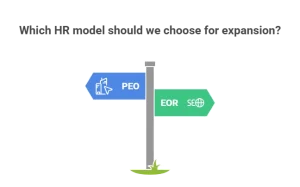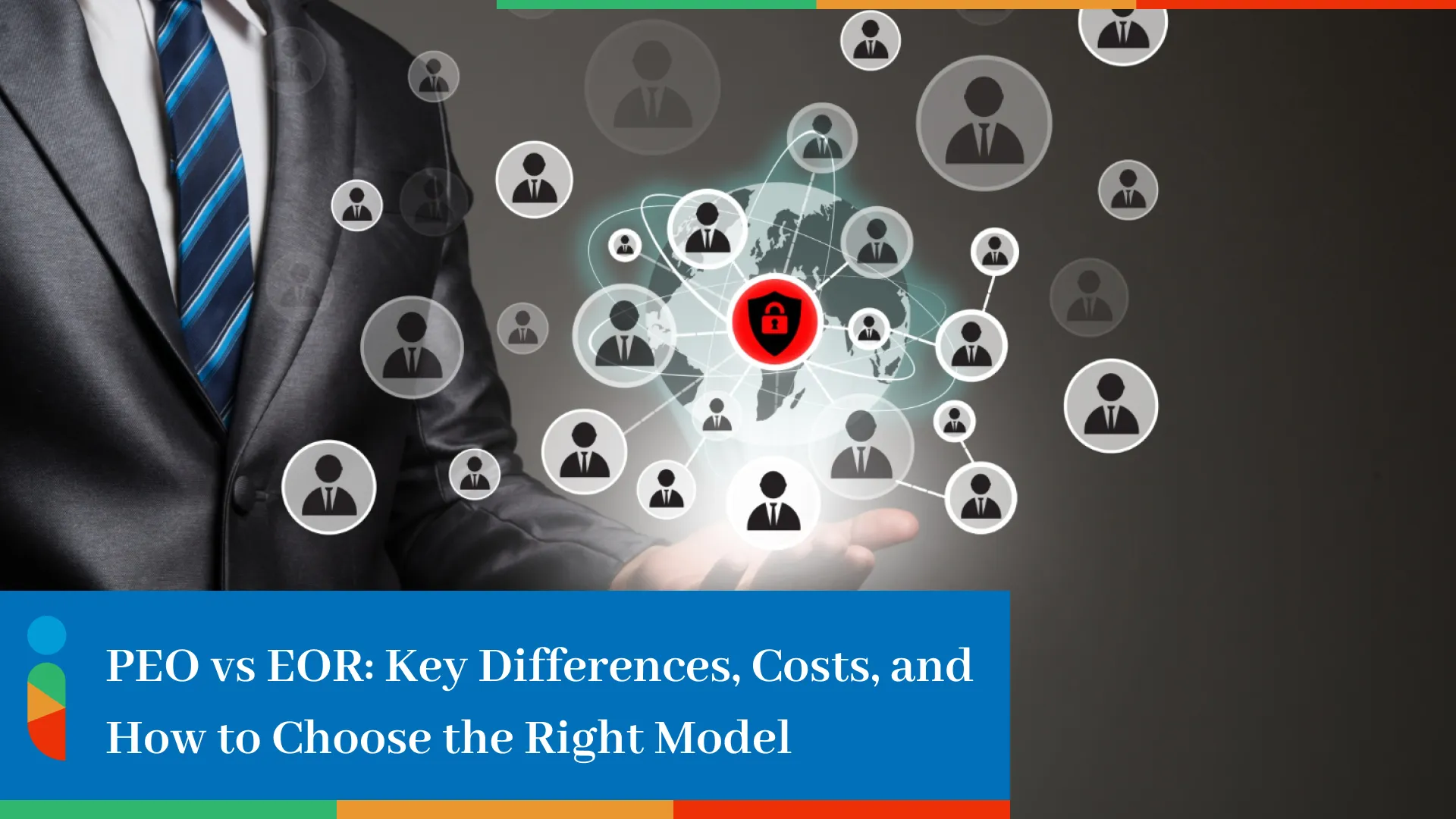Expanding a business-whether across state lines or into new countries-requires careful planning, especially when it comes to hiring and compliance. Two popular solutions for managing these challenges are Professional Employer Organizations (PEO) and Employer of Record (EOR) providers.
Both simplify HR and legal processes, but they operate very differently. Understanding the difference between a PEO and EOR can help you avoid compliance issues, reduce costs, and scale faster.
This guide breaks down PEO vs EOR services, their costs, pros and cons, and the scenarios where each model works best.

What Is a PEO (Professional Employer Organization)?
A Professional Employer Organization (PEO) is a third-party company that partners with businesses to provide comprehensive human resources services. Under a PEO arrangement, the PEO becomes a “co-employer,” sharing certain employment responsibilities with your company.
This co-employment model allows businesses to outsource tasks such as benefits administration, HR compliance, and the payroll process, while still maintaining day-to-day control over their workforce.
PEOs are ideal for companies that already have a legal entity in the country where they operate but want to reduce the administrative burden of HR. They are commonly used by small and mid-sized businesses that need help managing HR functions like recruitment, benefits, and workplace safety without hiring an entire internal HR team.
What Is an EOR (Employer of Record)?
An Employer of Record (EOR) takes a more direct role in employment. Instead of a co-employment arrangement, the EOR becomes the legal employer of your workers in the country where you want to hire.
This means the EOR handles all compliance-related tasks: drafting employment contracts, paying taxes, managing social contributions, and ensuring adherence to local labor laws. In short, the EOR assumes full legal responsibility for the employees.
EOR services are especially valuable for companies that want to hire talent in a new country without setting up a local subsidiary.
For example, if a U.S.-based tech firm wants to hire developers in Spain, an EOR can employ those workers on the company’s behalf, allowing the business to operate internationally within weeks instead of months.
PEO vs EOR: A Side-by-Side Comparison
Both models simplify HR management, but the difference between PEO and EOR lies in legal responsibility and geographic flexibility. Here’s how they compare:
| Feature | PEO (Professional Employer Organization) | EOR (Employer of Record) |
| Employment Relationship | Co-employer with shared responsibilities | Full legal employer of record |
| Entity Requirement | Your company must have a registered entity in the country | No local entity required |
| Compliance Responsibility | Shared with your company | EOR assumes full compliance responsibility |
| Scope of Services | HR support, benefits, payroll, risk management | Hiring, onboarding, payroll, taxes, employee contracts |
| Best Use Case | Domestic companies needing HR outsourcing | Global hiring without local entity |
| Cost Structure | Service fee based on payroll or per employee | Service fee plus country-specific employment costs |
When comparing PEO vs EOR cost, the pricing depends on factors like workforce size, location, and the complexity of local labor laws. PEOs typically charge a percentage of payroll or a per-employee fee, while EORs often use a flat monthly rate per employee.
Although an EOR might seem more expensive upfront, it eliminates the significant cost of setting up and maintaining a foreign entity.
Key Factors to Consider When Choosing Between PEO and EOR
Selecting the right model requires evaluating your business’s goals, size, and expansion plans:
Entity Status:
-
- If you already have a legal entity in the target country, a PEO may be more cost-effective.
- Without a local entity, an EOR is the only compliant option.
Hiring Speed:
-
- Need to hire employees quickly in a foreign market? An EOR can onboard talent within weeks.
- A PEO requires more setup time if you’re expanding into new states or regions.
Compliance Risk:
-
- EORs handle all compliance issues, from drafting an EOR contract to managing tax obligations.
- PEOs share compliance responsibilities, so you retain some legal risk.
Budget & Scale:
-
- Smaller businesses with limited HR staff might prefer PEOs for cost savings and shared services.
- Rapidly scaling global teams often benefit more from an EOR’s turnkey solution.
Pros and Cons of PEO and EOR
Understanding the strengths and weaknesses of each model can help avoid common HR mistakes that derail expansion plans.

Advantages of PEO
- Access to competitive employee benefits and insurance plans.
- Shared compliance responsibilities reduce HR workload.
- Ideal for domestic operations where you already have a registered entity.
Disadvantages of PEO
- Requires a local entity, which adds setup and maintenance costs.
- Your company still carries partial compliance responsibility.
Advantages of EOR
- Enables fast global hiring without opening a local entity.
- EOR assumes full compliance and legal responsibility.
- Simplifies onboarding and management of international employees.
Disadvantages of EOR
- Service fees can be higher than PEO costs for long-term operations.
- Less flexibility if you plan to establish a permanent local presence later.
Real-World Scenarios: Which Model Fits Your Business?
- PEO Example: A mid-sized U.S. marketing firm wants to improve HR efficiency and benefits offerings. They already operate domestically, so they engage PEO consulting services to handle HR administration while retaining control of employee management.
- EOR Example: A European startup wants to hire software engineers in Asia but lacks a legal entity there. They partner with an EOR to manage employment contracts, taxes, and payroll while focusing on business growth.
Transitioning from PEO to EOR
Businesses sometimes start with a PEO and later shift to an EOR as they expand globally. The transition typically involves:
- Reviewing existing HR agreements and ensuring all employee documents checklist items are complete.
- Terminating the co-employment arrangement with the PEO.
- Engaging an EOR to draft new employment contracts, take over payroll, and manage compliance.
Careful planning during this transition prevents disruptions to employee benefits and ensures legal continuity.
Conclusion
Choosing between a PEO and an EOR comes down to your business structure and expansion plans.
- If you have a local entity and need help managing HR administration, a PEO offers cost-effective support for payroll, compliance, and employee benefits.
- If you want to hire employees abroad without establishing a legal presence, an EOR provides a faster, fully compliant path to global growth.
Whether you’re outsourcing HR domestically or hiring internationally, understanding the difference between PEO and EOR ensures you make a strategic decision that supports long-term success.
Quick FAQs on PEO vs EOR
What Is the Difference Between a PEO and An EOR?
A PEO is a co-employer that provides HR support but requires your company to have a legal entity. An EOR is the full legal employer, allowing you to hire internationally without setting up a local entity.
Is a PEO Cheaper than An EOR?
Not always. PEOs may have lower service fees, but the cost of establishing and maintaining a foreign entity can exceed EOR fees.
Can a Company Use Both a PEO and An EOR?
Yes, some companies use a PEO domestically and an EOR for international hiring.
Do PEOs Handle Global Employment?
Typically, no. PEOs focus on domestic HR outsourcing. For global hiring, an EOR is more suitable.
Which Is Better for Small Businesses?
It depends on your goals. A PEO works well for small businesses operating in a single country, while an EOR is ideal for startups hiring talent abroad.






